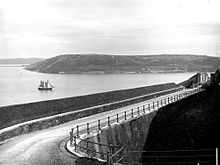Fort Davis, County Cork
| Fort Davis | |
|---|---|
Dún an Dáibhisigh | |
| Near Irish Defence Forces |
Fort Davis (
History
The coastline at Whitegate, north of

By the mid-19th century the defences had been renamed to Fort Carlisle (for Frederick Howard, 5th Earl of Carlisle a previous Lord Lieutenant of Ireland). In the 1850s, a Royal Commission gave renewed consideration to the strategic importance of the harbour, and proposed enhancements to the defences at Fort Mitchel (Spike Island), Fort Camden (Crosshaven), and Fort Carlisle. During the 1860s Fort Carlisle was therefore redeveloped along the lines of other "Palmerston Forts" in the region.[16] Some of this development took advantage of 19th century advancements in the use of concrete.[17]
During the
During "the Emergency" (1939–1945), elements of the Coastal Defence Artillery (CDA) of the Irish Artillery Corps operated from the fort.[19] By the mid- to late-20th century the CDA was merged into other artillery regiments of the Irish Army, and the fort primarily used as a training site. The site remains in the ownership of the Department of Defence and is used by the Irish Army for exercises,[20] ceremonial "gun salutes"[21] and other training purposes.[22][23]
Layout

The features of the fort date primarily to developments in the 19th century, when – at peak – the fort had upwards of 20 guns.[4]
On the landward side, a
On the seaward side,
- Main emplacement – Dating from the Napoleonic era, this is triangular in layout with one full bastion, two demi-bastions and one semi-circular bastion[4]
- Number 1 battery – As with several of the fort's other batteries, this dates from the Victorian reconstruction. Originally it had RML 7 inch guns (later reconstructed for three QF 12-pounder guns)
- Number 2 battery – RML 10 inch guns
- Number 3 battery – Moncrieff mountings for four RML 7 inch guns
- Number 4 battery – Casemated for four RML 10 inch guns (later converted to an oil store)
- North Battery – Two BL 6 inch coastal defence guns
- Rupert's Tower Battery – Two RML 12 inch guns (later rebuilt for two BL 6-inch Mk VII guns)
- South Battery – Two BL 9.2 inch guns
Other features of the fort include a military cemetery, a waterfront pier for sea-borne access, and a number of over-ground barracks and support buildings.[17]
Evidence of torpedo defences were discovered at the fort during clearing works in 2015.[24]
See also
References
- ^ English – Irish Dictionary of Military and Related Terms (PDF). Irish Defence Forces. 2007. p. 93. Retrieved 23 March 2015.
- ^ ISBN 1898256128.
- ^ "Written Answers – Defence Forces Property (Dáil Éireann Debate Vol. 696 No. 2)". Oireachtas.ie. 26 November 2009. Retrieved 19 March 2015.
- ^ a b c d "Victorian Forts and Artillery – Fort Carlisle PDF Datasheet" (PDF). Victorian Forts and Artillery. Retrieved 19 March 2015.
- ^ a b "A Yankee and Rebel Side by Side in Cork Harbour". Irish in the American Civil War. Retrieved 20 March 2015.
- ^ "Your Town – Cork Harbour: Forts Camden and Carlisle". Passage West Town Council. Retrieved 19 March 2015.
- ISBN 9782067182172.
- ^ "British Library – Gallery – 'A View of the old Castle of Cork in Cork Harbour'". British Library. 1700. Retrieved 19 March 2015.
- ^ James Coleman (1914). "The old castles around Cork Harbour". Journal of the Cork Historical and Archaeological Society. 2. XX: 161–75.
- ^ James Coleman (1915). "The old castles around Cork Harbour". Journal of the Cork Historical and Archaeological Society. 2. XXI: 105–12.
- ^ Samuel Lewis (1837). A Topographical Dictionary of Ireland. London. p. 429.
- ^ A fortified tunnel still bears the date 1797
- ^ "1830s OS Map". Ordnance Survey Ireland. Archived from the original on 29 August 2012. Retrieved 20 March 2015.
Marked on 1830s map as 'French Prison'
- ^ Parliamentary Papers, House of Commons and Command, Volume 53. House of Commons. 1852. p. 22.
Fort Carlisle consists of 2 rooms fitted up to receive 84 convicts [...] the premises termed the 'French Prison' might be converted into rooms [...]
- ^ Inspector of Government Prisons in Ireland annual report, 1852. HM Stationery Office. 1854. p. 17.
- ^ Ian Stevenson (February 1998). "The Cork Harbour Defences". The Redan (42). Palmerston Forts Society.
- ^ a b "Buildings of Ireland - Fort Davis". National Inventory of Architectural Heritage. Retrieved 19 March 2015.
- ^ "British Soldiers killed Ireland 1919–21 – Major Geoffry Lee Compton Smith". Cairogang.com. Retrieved 19 March 2015.
- ^ "Military Archives – Coastal Defence Artillery Collection". Irish Defence Forces: Military Archives. Archived from the original on 2 April 2014. Retrieved 20 March 2015.
- ^ "Written Answers – Defence Forces Property (Dáil Éireann Debate Vol. 565 No. 3)". Oireachtas.ie. 15 April 2003. Retrieved 19 March 2015.
- ^ "Press Release – Ceremony to mark the 75th Anniversary of Treaty Forts" (PDF). Cork County Council. July 2013. Archived from the original (PDF) on 2 April 2015. Retrieved 19 March 2015.
- ^ "Army > Organisation > 1st Brigade". Irish Defence Forces. Retrieved 23 March 2015.
- ^ Defence Forces Annual Report (PDF) (Report). Irish Defence Forces. 2003. p. 21. Retrieved 23 March 2015.
- ^ "VIDEO: Army find tunnel in Fort Davis". Irish Examiner. 2 November 2015. Retrieved 13 November 2016.
